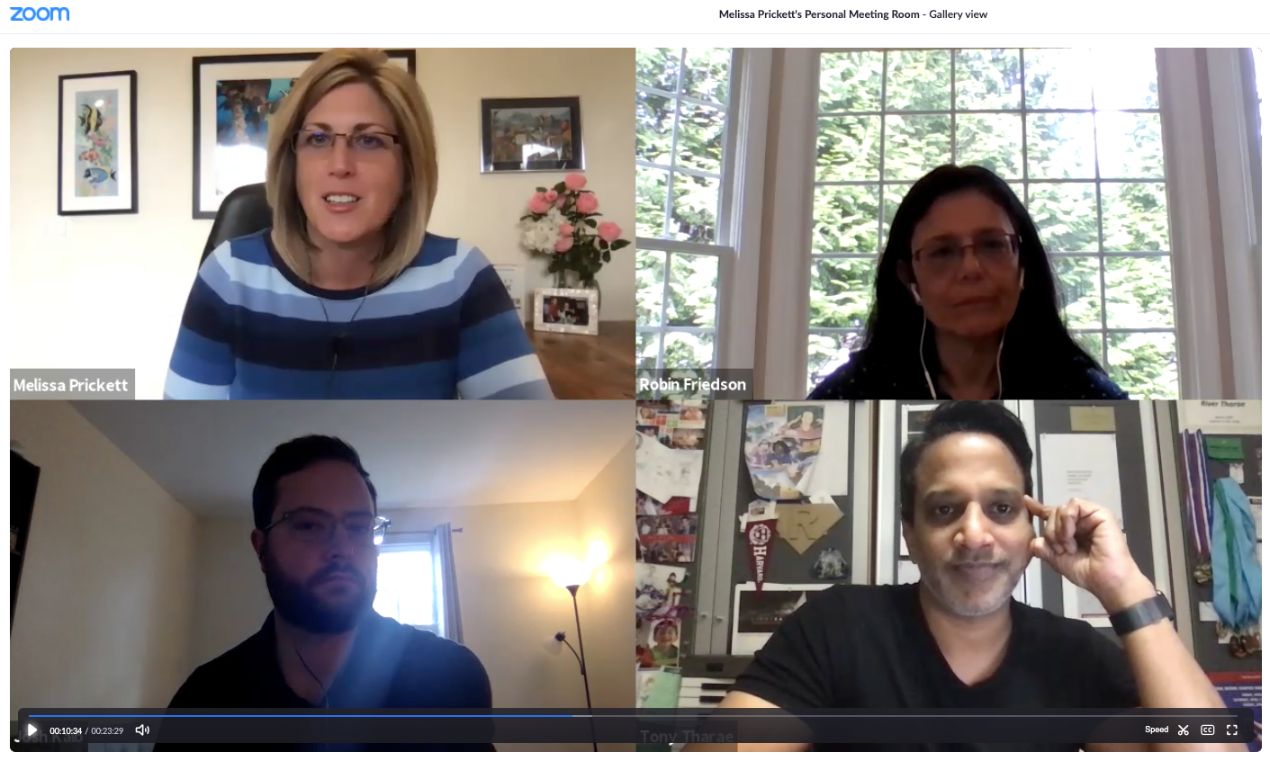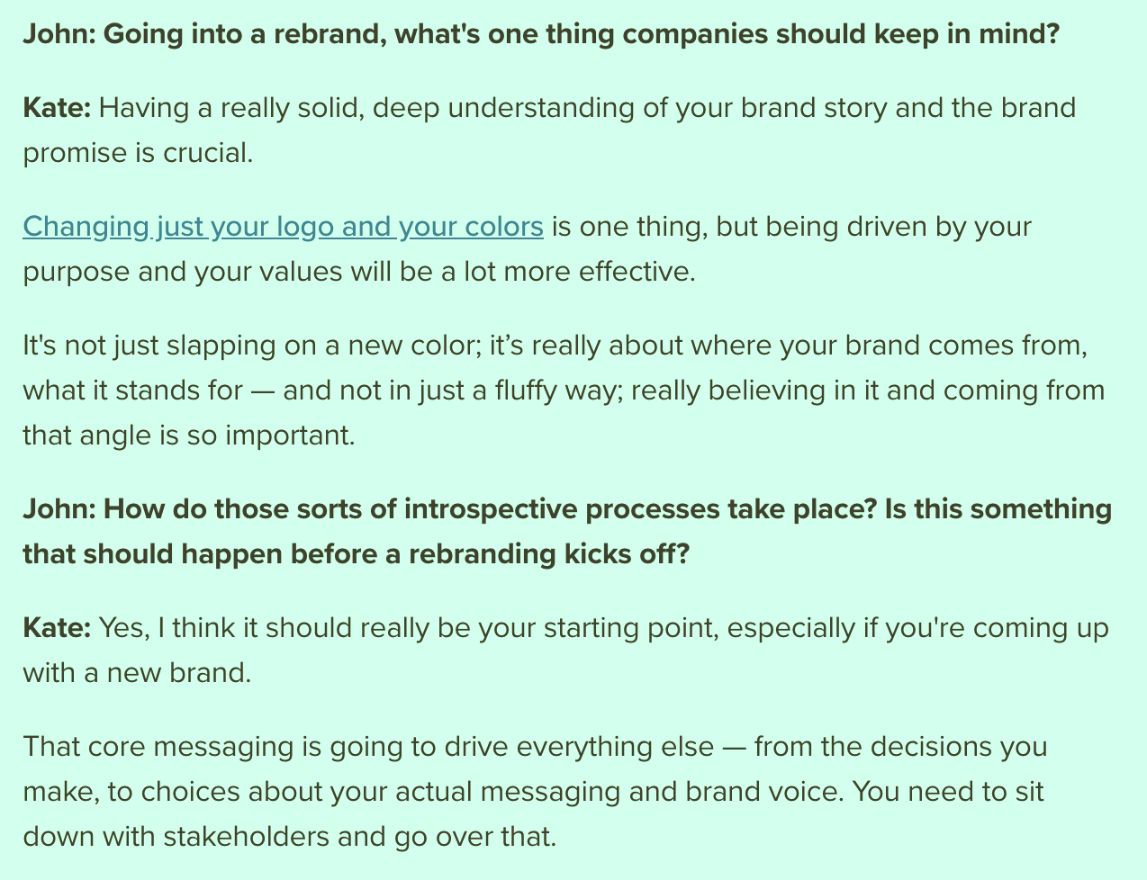Join 40,000+ sales and marketing pros who receive our weekly newsletter.
Get the most relevant, actionable digital sales and marketing insights you need to make smarter decisions faster... all in under five minutes.
3 essential lessons I learned in my first 90 days as a B2B content manager

By John Becker
Nov 11, 2020

To succeed as a B2B content manager:
- Develop processes to stay organized
- Devote time each week to watching sales calls
- Know the end result of each piece of content before you start writing
To the chagrin of several dear people in my life, I’m a bit of an over-planner — but it’s not my fault. I can remember the carefree weekends of college and young adult life where I slept in, made vague plans, and usually ended up playing guitars around a campfire with the same people as the weekend before.
Who needed plans back then?
But somewhere along the way I picked up a mortgage, had two kids, and began rationing my free time between household chores, pre-teen taxi service, and watching old Kitchen Nightmares episodes.
That’s where planning comes in.
That’s why, when our dog Millie wakes me up at 6:30 on a bleary Saturday, I’m up quickly, eager to get up and squeeze as much as I can from our family’s shared time off. By 7:00, I've got the whole weekend planned.
As you might expect, I bring this same mentality to work, too, where it is much better suited. Still, it’s not always an asset.
When Liz Moorehead, IMPACT’s editorial director, came to me in the summer and volun-told me that I would be transitioning to be our main “revenue editor,” I immediately began planning — even as I lay getting sunburned on a floating dock during a family vacation in Maine.
It was tough to plan when I didn't know exactly what a revenue editor did, and how this was different from my prior duties.
Practicing what we preach
The impetus behind this move was a long time coming. For years, IMPACT has helped businesses all over the world embrace the core tenets of They Ask, You Answer. To do so, businesses have to
- Obsess over their customer questions
- Provide helpful answers to these questions on their website
- Talk about price and other touchy subjects openly and candidly
Admittedly, it’s more complicated than that. True They Ask, You Answer mastery involves keyword research, SEO proficiency, a sophisticated content and video strategy, team realignment, and a company culture shift, among other things.
IMPACT has helped our clients put They Ask, You Answer into practice at their companies, and these clients have seen great success.
The thing was, we started to realize that we weren’t the best They Ask, You Answer example ourselves. So much of our publication strategy was focused on top-of-the-funnel, traffic-driving content that we weren’t really addressing customer questions directly. We were producing a good deal of video, too, but not at the three-per-week cadence we recommend to our clients.
It’s like the old saying, the shoemaker’s kids go barefoot.
We were so focused on others’ They Ask, You Answer success, we had ignored our own.
Don’t get me wrong, our content strategy was working. We were attracting more than 800,000 site visitors each month — and we were getting the bulk of our leads through organic search — but the content often wasn’t tied closely to helping our sales team close deals. And this is a central belief of They Ask, You Answer.
So, IMPACT made it a company priority.
We started to focus on being the best They Ask, You Answer example we could be, even working with some of our coaches who normally work with external clients. For example, Chris Marr helped us establish IMPACT’s revenue team, of which I am now a member. And Will Schultz still consults with our video team to make sure every video we publish helps us become best digital sales and marketing teacher we can be.
Being coached by our own team members felt a bit unnatural at times, but we started to see our own blind spots: We were producing the content that drove traffic, but we weren’t producing the content that helped sales close deals. We needed to redouble our efforts to connect our content to our sales process — something we always instructed our clients to do.
In turn, we created the revenue editor position, and I transitioned into it.
I had been working as IMPACT’s news and features editor, so I had my hand in a lot of what was published on our site.
I figured the new gig would be pretty much the same, right?
Nope.
The planner’s plan went out the window, and I learned a ton (sometimes the hard way) as I felt my way forward.
What I’ve learned in my first 90 days
In order to differentiate from our broader content strategy, IMPACT created a “revenue editor” role that focused specifically on bottom-of-the-funnel content directly related to sales. In many ways, this was more aligned with the traditional duties of a content manager, such as we present it to clients.
I took over as revenue editor in the middle of August, and in doing so I inherited about 15 article requests that were all at stage 0. Now, about 90 days later, I’ve written and published over 40 articles, with many more at various stages of completion.
While I’m certainly not a seasoned vet yet, I’ve garnered a few insights that will likely be useful for others getting started in the content manager role.
For me, success in this role comes down to three essential truths:
- You need to build a process
- You must dedicate time each week to listening to sales calls
- You should always know the output of each project
1. Build a process
Being the content manager of any company means sitting at the center of your organization’s content strategy. For us at IMPACT, this means that I’m responsible for writing and publishing at least three articles per week. Each article needs to be taken from its infant form — as a question the sales team has heard — to its final form: a researched, well-written, search engine optimized, complete answer to that question.
This means a lot of moving pieces that go through a lot of different stages and pass through a few different hands.
Without a well-articulated process, it’s easy to have something get lost in the shuffle.
Our organizational software: Trello
We use Trello to stay organized, with cards for each article I’m working on and columns that denote each step in the process, from “topic received” to “published and shared.”
Anyone can look at the Trello board and see exactly what stage each project is in. The cards hold all relevant files (Google docs, audio files, transcripts from interviews, images, and more) as well as checklists to make sure nothing gets overlooked.

The key to being successful in this role is to always be juggling a dozen or so projects — all in various stages of completion. For me, this means I can shift my attention as needed. If I’m hitting a wall on one piece that I’m struggling to write, I can put it aside and work on editing, interview prep, staging, or another task.
Writing works best for me if I can do it when the inspiration comes. Having many pieces in multiple stages means I can adjust your focus depending on where you’re feeling.
Extra tip: Have several irons in the fire
From start to finish, each piece I write goes through nine steps. As I write this currently, I have two pieces staged and scheduled for publication, four more awaiting feedback from subject matter experts (SMEs), one I’m drafting, four interviews scheduled for later this week, and 10 in my backlog that will move forward when I have the time.
Here are the steps in my content production process:
- Our sales department gives me a question they’ve been asked by a prospect. I ask follow-ups to understand who asked the question and when — as well as which SME would be the best one to help me answer it.
- I begin to strategize what type of article will best answer this question. I also write some related questions. (More on this later.)
- I reach out the SME to set up an interview and share my vision for the article.
- I interview our SME; make sure to record it and get a transcript to help me later.
- I write a first draft, keeping the customer's question in mind as I work.
- I get feedback from the SME to make sure I accurately answer the customer question.
- I stage the article, choose an associated image, include internal and external links, and follow all SEO best practices.
- I publish the article, checking traffic and and other metrics over the next few weeks.
- I gather feedback from sales. Is the article helping them close deals? Have they used it with prospects? Are there changes that could be made to make it more effective?
With an established process in place, you can handle all of your tasks without letting anything slip through the cracks.
🔎Related reading: How to create content from a subject matter expert interview in 7 steps
2. Listen to sales calls
This is a big one. If you’ve never worked in sales, you might have some misconceptions about how each individual sale actually happens. I know I did.
To truly serve your sales team, you need to see what they do every day.
This process will vary a little bit based on your organization. While some sales teams will welcome you to sit in on actual calls, I don’t recommend it. In the age of virtual sales, it’s nearly impossible to be a “fly on the wall” if you’re actually one more face in a meeting. Instead, ask your sales team if they record their calls. If they don’t, ask if they will.
Then, spend 30-45 minutes per week watching sales calls.

Watching sales calls was, for me, like watching a movie scene suddenly come into focus. Suddenly, something I had only thought about in the abstract was brought into sharp clarity.
Listening to sales calls led me to understand two things about the sales process:
Takeaway 1: Sales is a way more lengthy, complicated process than I had imagined
I had pictured sales being more scripted and brief. It’s more complex than I thought. Sales reps are not just answering questions, they’re managing emotions, shaping expectations, and building trust with prospects.
To watch a good sales rep in action is to see deft emotional intelligence on full display.
Takeaway 2: Salespeople are your business’ gatekeepers
I worked in education for over a decade. In that time, I served on admissions committees and got to see the demanding, often thankless work that admissions teams do. Admissions spend all of this time getting to know applicants, imaging how they will fit into an incoming class, how they will adjust to campus. Then, when they admit them, the admissions officers are on to the next year’s applicants, handing off the newly admitted students to faculty, advisors, and deans.
Salespeople function similarly. They are the vanguard of your organization, reaching out, shaking hands (virtually), and bringing clients on, then handing them off to the internal staff that will support them through their work with your organization.
Extra tip: Follow one contact through initially connect call all the way through to deal closed or deal lost
To truly understand the experience of buying from your company, watch how it happens for one particular client. Watching one prospect make it all the way through the buying process will give you incredibly valuable insights.
Keep these questions in mind:
- What were the prospect’s initial questions or concerns, and how did these concerns change over time?
- What content could have helped them at each stage?
- What were they most looking for?
- When they asked each question, what else was on their mind?
The more you know about how your company sells, the more effectively you can target your content to the prospect’s needs.
🔎Related reading: How to create sales enablement content that your sales team will adore
3. Know the end result of each piece of content
When I first receive a question from sales that will turn into a piece of content, I immediately begin thinking about the final product. For IMPACT, our articles take one of three formats, each of which is best suited to certain audience needs.
It’s vital that you know the output when you get started on each piece. This helps you plan.
Option 1: Q&A-type published interviews (about 10% of content)
This is what you typically think of as a published interview in a magazine: questions from the journalist and answers from the person being interviewed. There is back and forth and repartee.
For my needs, this is the publication output that is least taxing and can be turned around most quickly. Your transcript will still need a good deal of cleaning up and compressing, but the bulk of the content is created once you’ve completed your interview.
BEST FOR: This format is best for “what”-type questions from customers. What can I expect with… What will happen when… What are the drawbacks… What is the structure of...
For these types of sales questions, it’s easy to anticipate follow-up questions, and quick Q-and-A can yield an FAQ-type repository that’s skimmable and extremely useful for your audience. In practice, it looks like this:

Option 2: Standard written piece with SME input (about 60% of content)
This results in a piece written by you with input from SME(s). It is quick to produce and should be easy to write.
Unlike a Q&A-style article, your interview process for this piece does not have to be as rigid and formal. Figure out what you want to know from the SME and be prepared with questions and with follow-ups.
As you begin to draft questions, you can likely see how your final piece will be structured.
Again, think of what the customer wants to know who is asking this question. What’s on their mind? What stage of the sales process are they in?
BEST FOR: Most in-depth topics involving SME input, especially multiple SMEs. This works best for the “why” and “how” questions: How will your product… Why is this service… How can I...
You can easily add in additional outside research or multiple perspectives, as you have full authorial control.
Option 3: A ghostwritten piece for a company leader (about 30% of content)
You may be asked to ghostwrite for busy company leaders. In this case, make sure you can look at other things they’ve written — even emails — to get a sense of their style. Then, forward them the question you’ve gotten from sales, as well as any related questions of structure you deem appropriate.
Ghostwriting involves the most labor-intensive writing process. You want to be sure you’re getting this person’s voice just right. You can also anticipate more exacting revisions as you and your company leader work together to get the piece perfect.
BEST FOR: Establishing authority and thought leadership; getting company leaders’ voices out there for your customers.
Sometimes, voice matters. Having a company leader’s name on the byline can add authority and reputation, thereby changing the reading experience for the audience. The exact same text can be interpreted differently based on who owns the voice of the piece.
Extra tip: When you plan each interview, let your SME know the final outcome of the topic; This way, they can prepare
The more an SME knows in advance, the better. Make sure they feel comfortable with each stage of the process, and that they know what comes next. This way, they can feel like partners in the process.
How a content manager can be steady and nimble at the same time
When I inherited the revenue editor position at IMPACT, I knew I was being handed a new role that was a blank slate. My primary listed requirement was a regular publication cadence of three articles per week. How I did it was up to me.
As an obsessive planner, I knew that my success depended on my ability to build structure where none previously existed.
Now, more than three months in, I feel stable, productive, and responsive. Stability and productivity come by way of the processes that keep each piece moving forward, getting from one stage to the next.
Responsiveness, too, comes from structure. If the sales team suddenly asks for a certain piece of content to be streamlined — to be labeled “critical priority” for ASAP release — I know that I can pivot as needed to deliver the right assets when they’re required. A shift in my focus does not mean the entire train comes to a stop. Right now, I have articles already scheduled, and I have drafts with SMEs awaiting feedback.
Added together, this means I can be reliable and agile at the same time, serving my sales reps and my company — planning for success today and tomorrow.
Free Assessment: